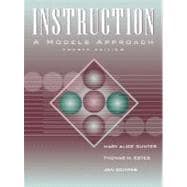
Note: Supplemental materials are not guaranteed with Rental or Used book purchases.
Purchase Benefits
What is included with this book?
Each chapter concludes with “Summary,” “Web Resources” and “Notes.”
I. PLANNING FOR INSTRUCTION.
1. Describing Educational Goals: The Learner, Society, and the Subject Matter.
Setting Goals.
National, State, and Local Standards.
Developing a Rationale.
2. Determining Educational and Instructional Objectives.
Defining Objectives.
Drafting Objectives.
Types of Objectives.
Determining Evaluation Strategies.
3. Organizing Content: Course, Unit, and Lesson Design.
Analyzing Content.
Ordering Content.
Unit Design.
Developing Lesson Plans.
Sample Outline for Lesson Planning.
Summary of Part One.
II. MATCHING OBJECTIVES TO INSTRUCTION: A MODELS APPROACH.
4. The Direct Instruction Model: Teaching Basic Skills, Facts, and Knowledge.
Steps in the Direct Instruction Model.
Summary of Steps in the Direct Instruction Model.
Basis for the Direct Instruction Model.
Scenario.
5. The Concept Attainment Model: Defining Concepts Inductively.
Steps in the Concept Attainment Model.
Summary of Steps in the Concept Attainment Model.
Variations on the Concept Attainment Model.
Basis for the Concept Attainment Model.
Scenario.
6. The Concept Development Model: Analyzing the Relationships between Parts of a Concept.
Understanding Concepts.
Steps in the Concept Development Model.
Summary of Steps in the Concept Development Model.
Basis for the Concept Development Model.
Scenario.
Benefits of Using the Concept Development Model.
7. The Inquiry Model: Teaching Problem Solving Through Discovery and Questioning.
Steps in the Suchman Inquiry Model.
Summary of Steps in the Suchman Inquiry Model.
Steps in the Web Quest Inquiry Model.
Basis for the Suchman Inquiry Model.
Scenario.
8. Synectics: Developing Creative Thinking and Problem Solving.
Version One: Making the Familiar Strange.
Steps in Synectics: Making the Familiar Strange.
Summary of Steps in Making the Familiar Strange.
Version Two: Making the Strange Familiar.
Steps in Synectics: Making the Strange Familiar.
Summary of Steps in Making Strange Familiar.
Version Three: The Synectics Excursion.
Steps in the Synectics Excursion.
Summary of Steps in the Synectics Excursion.
Basis for Synectics.
Scenario for Making the Familiar Strange.
9. The Cause and Effect Model: Influencing Events by Analyzing Causality.
Steps in the Cause and Effect Model.
The Steps in More Detail.
Summary of Steps in the Cause and Effect Model.
Comments on Conducting the Model.
Variations of the Cause and Effect Model.
Basis for the Cause and Effect Model.
Scenario.
10. The Classroom Discussion Model: Conducting Classroom Discussions Based on the Preparation of Factual, Interpretive, and Evaluative Questions.
Steps in the Classroom Discussion Model.
Summary of Steps in the Classroom Discussion Model.
Basis for the Classroom Discussion Model.
Scenario.
11. The Vocabulary Acquisition Model: Learning the Spellings and Meanings of Words.
Steps in the Vocabulary Acquisition Model.
Summary of Steps in the Vocabulary Acquisition Model.
Basis for the Vocabulary Acquisition Model.
Instructional Resources and Tools for Vocabulary Acquisition.
Scenario.
12. The Resolution of Conflict Model: Reaching Solutions Through Shared Perspectives.
Choosing a Conflict.
Steps in the Resolution of Conflict Model.
The Steps in More Detail.
Summary of Steps in the Resolution of Conflict Model.
Basis of the Resolution of Conflict Model.
High School Scenario.
Elementary School Scenario.
13. The Values Development Model: Mining the Curriculum for Ethical and Social Values.
Steps in the Values Development Model.
Summary of Steps in the Values Development Model.
Basis for the Values Development Model.
Scenario.
14. Cooperative Learning Models: Improving Student Achievement Using Small Groups.
Model One: The Jigsaw Model.
Steps in the Jigsaw Model.
Summary of Steps in the Jigsaw Model.
Model Two: The Role Playing Model.
Steps in the Role Playing Model.
Summary of the Steps in the Role Playing Model.
Additional Models.
The Team Interview Model.
The Graffiti Model.
The Think, Pair, Share Model.
Pointers for Using Cooperative Learning Teams Effectively.
Basis for the Models.
Scenario.
15. Models for Memory: Techniques for Improving the Recall of Information.
Conditions That Affect Memory.
Model One: The Link Model.
Steps in the Link Model.
Variations on the Link Model.
Summary of Steps in the Link Model.
Model Two: The Loci Model.
Steps in the Loci Model.
Summary of Steps in the Loci Model.
Model Three: The Memory Through Motion Model.
Steps in the Memory Through Motion Model.
Variations on the Memory Through Motion Model.
Summary of Steps in the Memory Through Motion Model.
Model Four: The Names and Faces Memory Model.
Steps in the Names and Faces Model.
Variations on the Names and Faces Model.
Summary of Steps in the Names and Faces Model.
Keyword Model for Foreign Language Instruction.
Steps in the Keyword Model.
Basis for the Memory Models.
Scenario.
Summary of Part Two.
III. PUTTING IT ALL TOGETHER: MATCHING OBJECTIVES TO INSTRUCTIONAL MODELS.
16. A Kindergarten Case Study.
Miss Abbott's Plan.
Unit: Lines That Draw Us Together.
Notes on Lessons One and Two.
Epilogue.
17. A Middle School Case Study.
The Mumford Plan.
Unit: Perspective—It All Depends on Where You Were When.
Epilogue.
18. A High School Case Study.
Mr. Samuels's Plan.
Unit: Macbeth—A Study in Ambition Turned to Avarice.
Epilogue.
19. The Wisdom of Practice: Creating a Positive Learning Environment.
Good Teachers Are in Charge of Their Classrooms.
Good Teachers Create a Pleasant Physical Environment for Learning.
Good Teachers Manage Human Relations Effectively.
Good Teachers Engage Learners in the Process of Their Own Learning.
Good Teachers Teach Up.
Good Teachers Are Good Learners.
Good Teachers Develop Instructional Objectives with Learners.
Good Teachers Find Out Why a Plan Is Not Working.
Good Teachers Strive to Make Their Teaching Interesting.
Good Teachers Give Learners Access to Information and Opportunity to Practice.
Good Teachers Teach for Two Kinds of Knowledge.
Summary of Part Three.
Index.
The New copy of this book will include any supplemental materials advertised. Please check the title of the book to determine if it should include any access cards, study guides, lab manuals, CDs, etc.
The Used, Rental and eBook copies of this book are not guaranteed to include any supplemental materials. Typically, only the book itself is included. This is true even if the title states it includes any access cards, study guides, lab manuals, CDs, etc.